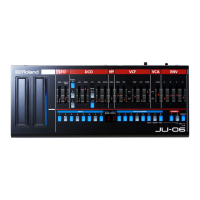VI. MIDI
A word about MIDI
MIDI is an acronym that stands for Musical Instrument Digital Interface. It is a technical standard that describes a
communications protocol, digital interface and electrical connectors and allows a wide variety of electronic musical
instruments, computers and other related music and audio devices to connect and communicate with one another.
A single MIDI link can carry up to sixteen channels of information, each of which can be routed to a separate device.
MIDI carries event messages that specify notation, pitch and velocity (loudness or softness), control signals for
parameters such as volume, vibrato, audio panning from left to right, cues in theatre, and clock signals that set and
synchronize tempo between multiple devices. These messages are sent via a MIDI cable to other devices where they
control sound generation and other features. A simple example of a MIDI setup is the use of a MIDI controller such as
an electronic musical keyboard to trigger sounds created by a sound module, which is in turn plugged into a keyboard
amplifier and speaker. This MIDI data can also be recorded into a hardware or software device called a sequencer,
which can be used to edit the data and to play it back at a later time.
Advantages of MIDI include file compactness (an entire song can be coded in a few hundred lines of code, i.e. in a
few kilobytes), ease of modification and manipulation and a wide choice of electronic instruments and synthesizer or
digitally-sampled sounds. Prior to the development of MIDI, electronic musical instruments from different
manufacturers were generally not compatible with each other, and they could not communicate with each other. With
MIDI, any MIDI-compatible keyboard (or other controller device) can be connected to any other MIDI-compatible
music sequencer, sound module, drum machine, synthesizer, or computer, even if they are made by different
manufacturers.
MIDI technology was standardized in 1983 by a panel of music industry representatives, and is maintained by the
MIDI Manufacturers Association (MMA). All official MIDI standards are jointly developed and published by the MMA in
Los Angeles, California, US, and for Japan, the MIDI Committee of the Association of Musical Electronics Industry
(AMEI) in Tokyo. In 2016, the MMA established The MIDI Association (TMA) to support a global community of people
who work, play, or create with MIDI, establishing the www.MIDI.org website as the central repository of information
about anything related to MIDI technology, from early MIDI technology to future developments.
Roland Boutique MIDI
Starting with firmware 1.10 the boutique line of modules from Roland are capable of sending CC data. This means
that all the slider and knob movements performed on the front panel of the JU-06 are cable of transmitting via MID for
recording into a DAW or MIDI sequencer.
To enable transmission of MIDI CC data:
1.
Hold the CHORUS 2 button and press PATCH 1 (9)
2.
2. Select 1-4
1 - OFF
2 - Output only to USB
3 - Output only to MIDI
4 - Output to USB and MIDI

